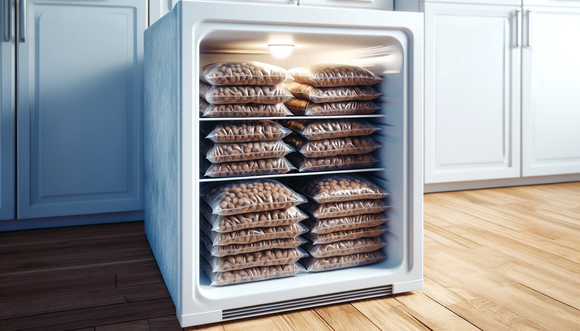Living with a dog with a food mite allergy: how to master the challenge

What are food mites and how do you recognize an allergy?
Understanding food mites
Food mites are tiny arachnids that are found in many types of dry food. They feed on the organic matter in food and are particularly active in warm and humid environments. Although they are harmless to most dogs, they can trigger allergic reactions in some.
Symptoms of a food mite allergy
The most common symptoms of a food mite allergy in dogs are
- Itching, especially on the paws, ears and belly
- Redness and inflammation of the skin
- Hair loss and bald patches
- Recurrent ear infections
- Digestive problems such as diarrhea or vomiting
If you observe these symptoms in your dog, it is advisable to consult a vet for an accurate diagnosis.
Mastering everyday life: tips and tricks
Select food
One of the most important things to do if your dog is allergic to food mites is to choose the right food. Here are a few tips:
- Avoid dry food: Dry food is particularly susceptible to food mites. Choose wet food or freshly prepared food(BARF) instead.
- Grain-free options: Many grain-based foods provide an ideal habitat for food mites. Grain-free food can reduce the risk.
- Hypoallergenic food: Special hypoallergenic foods are often a good choice for dogs with allergies.
Storage of the food
Storing food correctly is crucial to prevent food mites from multiplying:
- Store in a cool, dry place: store food in a cool, dry place to prevent mite growth.
- Airtight containers: Use airtight containers to protect the food from moisture and mite infestation.
- Buy small quantities: Buy the food in small quantities so that it is used up more quickly and there is less time for mites to multiply.
Regular cleaning
Cleanliness is key when it comes to controlling food mites:
- Clean food bowls daily: Wash your dog's food bowls daily with hot water and detergent.
- Keep feeding areas clean: Regularly clean the area where your dog eats to remove crumbs and food debris.
- Wash blankets and toys: Wash your dog's blankets and toys regularly at high temperatures to kill any mites.
Support your dog: Grooming routine and health
Skin care
As a food mite allergy often leads to skin problems, proper skin care is particularly important:
- Gentle shampoos: Use a hypoallergenic shampoo to cleanse your dog's skin without further irritating it.
- Moisturizing care products: Products with aloe vera or oats can help soothe and moisturize the skin.
Regular visits to the vet
Regular visits to the vet are important to monitor your dog's health and detect possible complications at an early stage.
Medication for the treatment of food mite allergies
Antihistamines
Antihistamines are often the first choice for treating allergy symptoms. They work by blocking the effect of histamine, a substance that is released during allergic reactions. Commonly used antihistamines for dogs are:
- Diphenhydramine (Benadryl)
- Loratadine (Claritin)
- Cetirizine (Zyrtec)
These medications can help relieve itching and skin irritation. However, be sure to talk to your vet before giving your dog an antihistamine to ensure the correct dosage and safety.
Corticosteroids
Corticosteroids are powerful anti-inflammatory drugs that are often used for severe allergic reactions. They can help to quickly reduce inflammation and itching. Common corticosteroids include:
- Prednisone
- dexamethasone
- methylprednisolone
As corticosteroids can have side effects, they should only be used under the strict supervision of a veterinarian and in the lowest possible effective dose.
Immunotherapy
Immunotherapy is a long-term treatment in which the dog is regularly administered small amounts of the allergen to desensitize the immune system. This therapy is often referred to as "allergy shots" and can be particularly effective in dogs with severe allergies. Immunotherapy requires patience as it can take several months to see an improvement.
Omega-3 fatty acids
Supplements containing omega-3 fatty acids can help improve skin health and reduce inflammation. These fatty acids are available in fish oil capsules or special supplements for dogs. Omega-3 fatty acids support the skin barrier and can help to relieve itching and dryness.
Special diets and supplements
Sometimes a specially formulated diet can also be helpful. Hypoallergenic diets containing hydrolyzed proteins or novel protein sources can reduce the risk of an allergic reaction. Supplements such as probiotics can also support the immune system and promote digestive health.
Working with your vet
It's important to work closely with your vet to develop the best treatment strategy for your dog. The vet can:
- Confirm diagnosis: Using skin tests or blood tests, the veterinarian can confirm that it is indeed a food mite allergy.
- Create a treatment plan: Together you can create a customized treatment plan that is tailored to your dog's specific needs.
- Adjust medication dosage: The veterinarian can determine the correct dosage and combination of medications and adjust them as needed.
With the right medication, combined with preventative measures and an adapted diet, you can help your dog get their food mite allergy under control and lead a happy, healthy life.
Snacks for dogs with food mite allergy
Dogs with a food mite allergy can still enjoy tasty snacks if you take some precautions. Here are some suggestions for suitable snacks that you can safely give your allergic dog:
Homemade snacks
Homemade dog snacks are a great option as you know exactly what ingredients are included and how they have been processed.
Sweet potato chews
- Ingredients:Sweet potatoes
- Preparation: Cut the sweet potatoes into thin slices and bake them in the oven at a low temperature (approx. 120°C) for 3-4 hours until they are dry and crispy.
Chicken strips
- Ingredients:Chicken breast fillets
- Preparation: Cut the chicken breast into thin strips and dry them in the oven at 120°C for about 2-3 hours.
Carrot sticks
- Ingredients:Fresh carrots
- Preparation: Cut the carrots into long, thin sticks. These can be served raw or lightly steamed as a snack.
Hypoallergenic ready-made snacks
There are also numerous hypoallergenic snacks on the market that have been specially developed for dogs with allergies. Make sure that the snacks do not contain common allergens such as cereals, beef or dairy products.
Hypoallergenic treats
These are available in pet stores and online and often contain hydrolyzed proteins or rare protein sources such as duck, rabbit or fish.
Freeze-dried snacks
Freeze-dried snacks are made from pure meat or fish and contain no additional ingredients that could trigger allergies. Popular options are:
- Freeze-dried Chicken hearts
- Freeze-dried salmon
- Freeze-dried turkey breast
Fresh and natural snacks
Some fresh foods are also suitable and can be given to your dog as healthy and safe snacks.
Fruit and vegetables
Many fruits and vegetables are safe for dogs and offer a nutritious alternative to commercial snacks. Suitable options include:
- Apples (without seeds)
- blueberries
- cucumbers
- zucchinis
Chews
Natural chews are another great way to give your dog a tasty and safe snack.
- Deer antlers are hypoallergenic and offer a long-lasting chew option.They are rich in minerals and do not splinter.
- Kangaroo bones are an exotic source of protein and a good hypoallergenic alternative to traditional chews.
With a little planning and the right choice, you can offer your dog with food mite allergy many tasty and safe snacks. Homemade snacks and hypoallergenic ready-made snacks are ideal options to ensure your four-legged friend stays healthy and happy.
Why freezing food is helpful
Freezing food can be very helpful in controlling food mites. Here are some reasons why freezing food can be a good strategy and tips on how best to go about it:
Killing food mites
- Food mites cannot survive at low temperatures.By freezing the food, you can kill the mites and thus significantly reduce the burden on your dog.
Prevent mite growth
- Even if the food does not contain mites,freezing can help,prevent future colonization.Mites breed particularly well in warm and humid environments,which are avoided by freezing.
How you can freeze the food
Preparation
- Freeze in portions: Divide the food into small portions that can be consumed within a few days. This way you can ensure that the food stays fresh and there is no mite contamination.
- Airtight containers: Use airtight freezer bags or containers to freeze the food. This protects the food from moisture and freezer burn.
Freezing time
- Freeze for a sufficiently long time: Leave the food in the freezer for at least 48 hours. This time is usually sufficient to kill mites.
Defrosting
- Gradual defrosting: Only take the amount of food out of the freezer that you can consume within a few days. Allow the food to thaw in the refrigerator to prevent re-colonization by mites.
Storage after defrosting
- Store in a cool, dry place: Keep the defrosted food in a cool, dry place. Use airtight containers to keep the food fresh and prevent mite growth.
A food mite allergy can have a significant impact on your dog's daily life, but with the right care and prevention, you can do a lot to help them live a symptom-free life. By choosing the right food, careful storage and regular cleaning, as well as the support of suitable care products and visits to the vet, you can effectively alleviate the symptoms and help your dog lead a happy and healthy life.
More articles for you
Contact form problem fixed
Unfortunately, our contact form has not worked as desired in recent weeks. 😔 Due to an error in the spam detection, normal messages were also incorrectly filtered out.Read moreDangerous encounter: What you should do if your dog is bitten by a snake
It's every dog owner's nightmare: you're out in nature with your four-legged friend, he's sniffing the ground curiously, and suddenly you hear a hissing sound. Before you know it, your dog flinches and you recognize the signs of a snake bite. But don't panic! In this article, you will learn how to…Read moreWhat you should know about cherries for dogs
You may have heard that cherries are good for your health. They contain lots of vitamins, antioxidants and fiber, which can strengthen the immune system and aid digestion. But are cherries also suitable for dogs? And if so, how much and in what form should you offer them to your four-legged friend?…Read more


